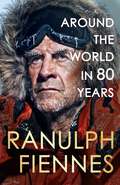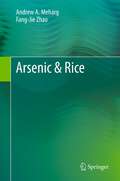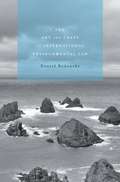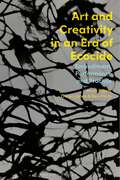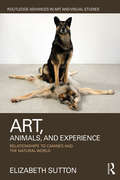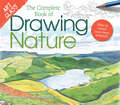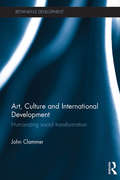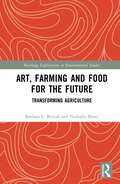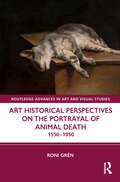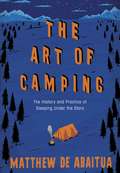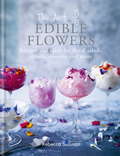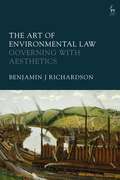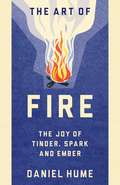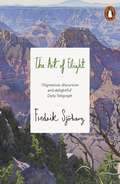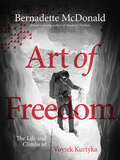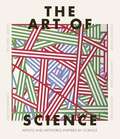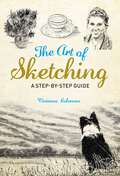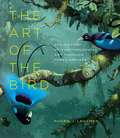- Table View
- List View
Around the World in 80 Years: A Life of Exploration
by Ranulph FiennesHe's climbed Everest not long after a heart bypass operation, he's run seven marathons on seven continents, he's hauled loaded sledges across both polar ice caps and he's circumnavigated the earth...Ran Fiennes truly is the world's greatest explorer, and this book celebrates his 80th birthday by showcasing his greatest achievements in his own words. Featuring interviews and tributes from his friends, colleagues and admirers, Around the World in 80 Years celebrates the incredible life of a legendary explorer.
Arsenic & Rice
by Andrew A. Meharg Fang-Jie ZhaoRice is the staple food for half of the world’s population. Consumption of rice is the major exposure route globally to the class one, non-threshold carcinogen inorganic arsenic. This book explains the sources of arsenic to paddy soils and the biogeochemical processes and plant physiological attributes of paddy soil-rice ecosystems that lead to high concentrations of arsenic in rice grain. It presents the global pattern of arsenic concentration and speciation in rice, discusses human exposures to inorganic arsenic from rice and the resulting health risks. It also highlights particular populations that have the highest rice consumptions, which include Southern and South East Asians, weaning babies, gluten intolerance sufferers and those consuming rice milk. The book also presents the information of arsenic concentration and speciation in other major crops and outlines approaches for lowering arsenic in rice grain and in the human diet through agronomic management.
The Art and Craft of International Environmental Law
by Daniel BodanskyInternational environmental law is often closer to home than we know, affecting the food we eat, the products we buy, and even the air we breathe. Drawing on more than two decades of experience as a government negotiator, consultant, and academic, Daniel Bodansky brings a real-world perspective on the processes by which international environmental law develops, and influences the behavior of state and non-state actors.
Art and Creativity in an Era of Ecocide: Embodiment, Performance and Practice
by Anna Pigott, Owain Jones and Ben ParryWhat can creativity achieve in an era of ecocide? How are people using creative and artistic practices to engage with (and resist) the destruction of life on earth? What are the relationships between creativity and repair in the face of escalating global environmental crises? Across twelve compelling case studies, this book charts the emergence of diverse forms of artistic practice and brings together accounts of how artists, scholars and activists are creatively responding to environmental destruction.Highlighting alternative approaches to creativity in both conventional art settings and daily life, the book demonstrates the major influence that ecological thought has had on contemporary creative practices. These are often more concerned with subtle processes of feeling, experience and embodiment than they are with charismatic 'eco-art' works. In doing so, this exploratory book develops a conception of creativity as an anti-ecocide endeavour, and provides timely theoretical and practical insights on art in an age of environmental destruction.
Art and Creativity in an Era of Ecocide: Embodiment, Performance and Practice
What can creativity achieve in an era of ecocide? How are people using creative and artistic practices to engage with (and resist) the destruction of life on earth? What are the relationships between creativity and repair in the face of escalating global environmental crises? Across twelve compelling case studies, this book charts the emergence of diverse forms of artistic practice and brings together accounts of how artists, scholars and activists are creatively responding to environmental destruction.Highlighting alternative approaches to creativity in both conventional art settings and daily life, the book demonstrates the major influence that ecological thought has had on contemporary creative practices. These are often more concerned with subtle processes of feeling, experience and embodiment than they are with charismatic 'eco-art' works. In doing so, this exploratory book develops a conception of creativity as an anti-ecocide endeavour, and provides timely theoretical and practical insights on art in an age of environmental destruction.
Art, Animals, and Experience: Relationships to Canines and the Natural World (Routledge Advances in Art and Visual Studies)
by Elizabeth SuttonElizabeth Sutton, using a phenomenological approach, investigates how animals in art invite viewers to contemplate human relationships to the natural world. Using Rembrandt van Rijn’s etching of The Presentation in the Temple (c. 1640), Joseph Beuys’s social sculpture I Like America and America Likes Me (1974), archaic rock paintings at Horseshoe Canyon, Canyonlands National Park, and examples from contemporary art, this book demonstrates how artists across time and cultures employed animals to draw attention to the sensory experience of the composition and reflect upon the shared sensory awareness of the world.
Art, Animals, and Experience: Relationships to Canines and the Natural World (Routledge Advances in Art and Visual Studies)
by Elizabeth SuttonElizabeth Sutton, using a phenomenological approach, investigates how animals in art invite viewers to contemplate human relationships to the natural world. Using Rembrandt van Rijn’s etching of The Presentation in the Temple (c. 1640), Joseph Beuys’s social sculpture I Like America and America Likes Me (1974), archaic rock paintings at Horseshoe Canyon, Canyonlands National Park, and examples from contemporary art, this book demonstrates how artists across time and cultures employed animals to draw attention to the sensory experience of the composition and reflect upon the shared sensory awareness of the world.
Art Class: How to Create Your Own Artwork (Art Class)
by Barrington BarberThis full-colour drawing book guides readers through the many aspects of the natural world, written by internationally bestselling practical art author Barrington Barber. Presented in a useful lay-flat landscape format, this essential reference guide includes accessible step-by-step drawing projects starting with a close observation of plants and flowers, before exploring the possibilities of still lifes that can be made in the comfort of your own home. Other subjects include: • Outdoor elements, including tress, rocks, water and sky • Animals, from crabs to tigers • Landscapes and their composition Whether you are drawing in a garden, a park or the open countryside, you will find it extremely rewarding to create a record of where you have been and a feel greater connection to the natural world.With clear, practical advice for every step of the process for artists at every level, from the basics of choosing supplies to advanced techniques, this is the ultimate guide to nature drawing. ABOUT THE SERIES: Arcturus' Art Class books are a curated series of instructional art and craft titles designed to inspire artists of all levels, from beginner to professional. Stunningly presented in full colour, and in a highly usable landscape format, these comprehensive books are packed with all the ideas, inspirations, step-by-step projects, and techniques you'll need to master the subject covered.
Art, Culture and International Development: Humanizing social transformation (Rethinking Development)
by John ClammerCulture is not simply an explanation of last resort, but is itself a rich, multifaceted and contested concept and set of practices that needs to be expanded, appreciated and applied in fresh ways if it is to be both valued in itself and to be of use in practical development. This innovative book places culture, specifically in the form of the arts, back at the centre of debates in development studies by introducing new ways of conceptualizing art in relation to development. The book shows how the arts and development are related in very practical ways – as means to achieve development goals through visual, dramatic, filmic and craft-inspired ways. It advocates not so much culture and development, but rather for the development of culture. Without a cultural content to economic and social transformation the problems found in much development – up-rooting of cultures, loss of art forms, languages and modes of expression and performance – may only accelerate. Paying attention to the development of the arts as the content of development helps to amend this culturally destructive process. Finally, the book argues for the value of the arts in attaining sustainable cultures, promoting poverty alleviation, encouraging self-empowerment, stimulating creativity and the social imagination, which in turn flow back into wider processes of social transformation. Discussion questions at the end of each chapter make this book ideal to help foster further thinking and debate. This book is an inspiring read for postgraduate students and researchers in the fields of development studies, cultural studies and sociology of development.
Art, Culture and International Development: Humanizing social transformation (Rethinking Development)
by John ClammerCulture is not simply an explanation of last resort, but is itself a rich, multifaceted and contested concept and set of practices that needs to be expanded, appreciated and applied in fresh ways if it is to be both valued in itself and to be of use in practical development. This innovative book places culture, specifically in the form of the arts, back at the centre of debates in development studies by introducing new ways of conceptualizing art in relation to development. The book shows how the arts and development are related in very practical ways – as means to achieve development goals through visual, dramatic, filmic and craft-inspired ways. It advocates not so much culture and development, but rather for the development of culture. Without a cultural content to economic and social transformation the problems found in much development – up-rooting of cultures, loss of art forms, languages and modes of expression and performance – may only accelerate. Paying attention to the development of the arts as the content of development helps to amend this culturally destructive process. Finally, the book argues for the value of the arts in attaining sustainable cultures, promoting poverty alleviation, encouraging self-empowerment, stimulating creativity and the social imagination, which in turn flow back into wider processes of social transformation. Discussion questions at the end of each chapter make this book ideal to help foster further thinking and debate. This book is an inspiring read for postgraduate students and researchers in the fields of development studies, cultural studies and sociology of development.
Art, Farming and Food for the Future: Transforming Agriculture (Routledge Explorations in Environmental Studies)
by Barbara L. Benish Nathalie BlancThis book explores the impact of artistic experiments in inspiring people to turn away from current food consumerism and take an active role in preserving, sustaining, and protecting the environment. As artists are expanding their practice into social justice and community concerns, erasing traditional forms of expression and integrating others, the culture around food and its production has been added to a new vocabulary of experiential art. The authors measure the impact of such experiments on local food consumption and production, focusing on education and youth, both in the surrounding community and culture at large. They suggest how these projects can be up-scaled to further encourage sustainable solutions for our environment and communities. The book explores the reflections and motivations of case study practitioners in urban and rural areas and, through interviews, engages with artists who are pioneering a new trend to create hubs of activity away from traditional art spaces in cities to follow a non-hierarchal practice that is de-centralized and communally based. This book will be of great interest to academic readers concerned with issues related to environmental aesthetics, eco-design, eco-criticism, culture, heritage, memory, and identity, and those interested in the current debates on the place of aesthetics and culture in sustainability.
Art, Farming and Food for the Future: Transforming Agriculture (Routledge Explorations in Environmental Studies)
by Barbara L. Benish Nathalie BlancThis book explores the impact of artistic experiments in inspiring people to turn away from current food consumerism and take an active role in preserving, sustaining, and protecting the environment. As artists are expanding their practice into social justice and community concerns, erasing traditional forms of expression and integrating others, the culture around food and its production has been added to a new vocabulary of experiential art. The authors measure the impact of such experiments on local food consumption and production, focusing on education and youth, both in the surrounding community and culture at large. They suggest how these projects can be up-scaled to further encourage sustainable solutions for our environment and communities. The book explores the reflections and motivations of case study practitioners in urban and rural areas and, through interviews, engages with artists who are pioneering a new trend to create hubs of activity away from traditional art spaces in cities to follow a non-hierarchal practice that is de-centralized and communally based. This book will be of great interest to academic readers concerned with issues related to environmental aesthetics, eco-design, eco-criticism, culture, heritage, memory, and identity, and those interested in the current debates on the place of aesthetics and culture in sustainability.
Art Historical Perspectives on the Portrayal of Animal Death: 1550–1950 (Routledge Advances in Art and Visual Studies)
by Roni GrénThis study concentrates on the discourses around animal death in arts and the ways they changed over time.Chapter topics span from religious symbolism to natural history cabinets, from hunting laws to animal rights, from economic history to formalist views on art. In other words, the book asks why artists have represented animal death in visual culture, maintaining that the practice has, through the whole era, been a crucial part of the understanding of our relation to the world and our identity as humans. This is the first truly integrative book-length examination of the depiction of dead animals in Western art.The book will be of interest to scholars working in art history, animal studies, and cultural history.
Art Historical Perspectives on the Portrayal of Animal Death: 1550–1950 (Routledge Advances in Art and Visual Studies)
by Roni GrénThis study concentrates on the discourses around animal death in arts and the ways they changed over time.Chapter topics span from religious symbolism to natural history cabinets, from hunting laws to animal rights, from economic history to formalist views on art. In other words, the book asks why artists have represented animal death in visual culture, maintaining that the practice has, through the whole era, been a crucial part of the understanding of our relation to the world and our identity as humans. This is the first truly integrative book-length examination of the depiction of dead animals in Western art.The book will be of interest to scholars working in art history, animal studies, and cultural history.
The Art of Camping: The History and Practice of Sleeping Under the Stars
by Matthew De AbaituaCould there be another way of life? Can I survive with less stuff? Should I run for the hills?These are all good questions that people have asked before, throughout history, and which have inspired people to set up camp. But now camping is part of the drive for self-sufficiency, a reaction against mass tourism, a chance to connect with the land, to experience a community, to leave no trace . . . From packing to pitching, with hikes into the deep history of the subject and encounters with the great campers and camping movements of the past, this is the only book you'll need to pack when you next head off to sleep under the stars.IF THERE IS ONE THING THAT CAMPERS LIKE MORE THAN CAMPING, IT'S DREAMING ABOUT THEIR NEXT TRIP
The Art of Edible Flowers: Recipes and ideas for floral salads, drinks, desserts and more (Art of series)
by Rebecca SullivanThis gorgeous little book is a joyful exploration of the many ways in which flowers can be used in a range of delicious recipes. From Rose and Lavender Cocktail Syrup to Jasmine and Green Tea Ice Cream, the ideas and flavours are subtly, deliciously floral. Savoury options include Courgette Carpaccio with Wood Sorrel Flowers and Artichokes with Roasted Garlic and Chive Flowers, while the drinks range from Fermented Elderflower Fizz to soothing Poppy Milk.Rebecca's creative ideas and thoughtful approach make the entire process of cooking a mindful experience, from picking the flowers through to the very last bite.Bursting with beautiful creations and infused with natural flavours, this volume offers recipes suitable for all abilities.
The Art of Environmental Law: Governing with Aesthetics
by Benjamin J RichardsonEnvironmental law has aesthetic dimensions. Aesthetic values have shaped the making of environmental law, and in turn such law governs many of our nature-based sensory experiences. Aesthetics is also integral to understanding the very fabric of environmental law, in its institutions, procedures and discourses. The Art of Environmental Law, the first book of its kind, brings new insights into the importance of aesthetic issues in a variety of domains of environmental governance around the world, from climate change to biodiversity conservation. It also argues for aesthetics, and relatedly the arts, to be taken more seriously in the practice of environmental law so as to improve our emotional and ethical capacities to address the upheavals of the Anthropocene.
The Art of Environmental Law: Governing with Aesthetics
by Benjamin J RichardsonEnvironmental law has aesthetic dimensions. Aesthetic values have shaped the making of environmental law, and in turn such law governs many of our nature-based sensory experiences. Aesthetics is also integral to understanding the very fabric of environmental law, in its institutions, procedures and discourses. The Art of Environmental Law, the first book of its kind, brings new insights into the importance of aesthetic issues in a variety of domains of environmental governance around the world, from climate change to biodiversity conservation. It also argues for aesthetics, and relatedly the arts, to be taken more seriously in the practice of environmental law so as to improve our emotional and ethical capacities to address the upheavals of the Anthropocene.
The Art of Fire: Step by step guide to starting, building and handling fires
by Daniel HumeFire can fascinate, inspire, capture the imagination and bring families and communities together. It has the ability to amaze, energise and touch something deep inside all of us. For thousands of years, at every corner of the globe, humans have been huddling around fires: from the basic and primitive essentials of light, heat, energy and cooking, through to modern living, fire plays a central role in all of our lives.The ability to accurately and quickly light a fire is one of the most important skills anyone setting off on a wilderness adventure could possess, yet very little has been written about it. Through his narrative Hume also meditates on the wider topics surrounding fire and how it shapes the world around us.
The Art of Flight
by Fredrik SjöbergAccidental Journeys with the Bestselling Author of The Fly TrapStories just begin. We rarely know where and almost never why. It doesn't matter. Nothing is certain any longer. I just want to shut my eyes, point at random and say, as a sort of experiment, that once, when I was sixteen years old, I spent a whole night singing romantic songs in the top of a pine tree. That's where it may have started.Fredrik Sjöberg continues his exploration of the pleasures and trials of those who spend their time tracing the smallest details of the natural world in these two tales of ambition, fear and hapless romance. Calling on his childhood memories and experience as a hoverfly collector, and following the trail of long forgotten entomologists before him who left their native Sweden for the national parks of the United States, Sjöberg contemplates the richness of life and the strange paths it leads us on.
Art of Freedom: The life and climbs of Voytek Kurtyka
by Bernadette McDonaldVoytek Kurtyka is one of the greatest alpinists of all time. Born in 1947, he was one of the leading lights of the Polish golden age of mountaineering that redefined Himalayan climbing in the 1970s and 1980s.His visionary approach to climbing resulted in many renowned ascents, such as the complete Broad Peak traverse, the ‘night-naked’ speed climbs of Cho Oyu and Shishapangma and, above all, the alpine-style first ascent of the West Face of Gasherbrum IV. Dubbed the ‘climb of the century’, his route on GIV with the Austrian Robert Schauer is – as of 2017 – unrepeated. His most frequent climbing partners were alpine legends of their time: Polish Himalayan giant Jerzy Kukuczka, Swiss mountain guide Erhard Loretan and British alpinist Alex MacIntyre.After repeated requests to accept the Piolets d’Or Lifetime Achievement Award (the Oscars of the climbing world), Kurtyka finally accepted the honour in the spring of 2016. A fiercely private individual, he has declined countless invitations for interviews, lectures and festival appearances, but he has agreed to collaborate with internationally renowned and award-winning author Bernadette McDonald on this long-awaited biography.Art of Freedom is a profound and moving profile of one of the international climbing world’s most respected, complex and reclusive mountaineers.
The Art of Migration: Birds, Insects, and the Changing Seasons in Chicagoland
by John Bates Peggy Macnamara James H. BooneTiny ruby-throated hummingbirds weighing less than a nickel fly from the upper Midwest to Costa Rica every fall, crossing the six-hundred-mile Gulf of Mexico without a single stop. One of the many creatures that commute on the Mississippi Flyway as part of an annual migration, they pass along Chicago’s lakefront and through midwestern backyards on a path used by their species for millennia. This magnificent migrational dance takes place every year in Chicagoland, yet it is often missed by the region’s two-legged residents. The Art of Migration uncovers these extraordinary patterns that play out over the seasons. Readers are introduced to over two hundred of the birds and insects that traverse regions from the edge of Lake Superior to Lake Michigan and to the rivers that flow into the Mississippi. As the only artist in residence at the Field Museum, Peggy Macnamara has a unique vantage point for studying these patterns and capturing their distinctive traits. Her magnificent watercolor illustrations capture flocks, movement, and species-specific details. The illustrations are accompanied by text from museum staff and include details such as natural histories, notable features for identification, behavior, and how species have adapted to environmental changes. The book follows a gentle seasonal sequence and includes chapters on studying migration, artist’s notes on illustrating wildlife, and tips on the best ways to watch for birds and insects in the Chicago area. A perfect balance of science and art, The Art of Migration will prompt us to marvel anew at the remarkable spectacle going on around us.
The Art of Science: Artists and artworks inspired by science
by Heather Barnett Richard J BrightArt and science – they may seem like opposites, but throughout history there have been visionaries who have brought together these contrasting subjects.The Art of Science explores the work of 40 such artists and artist-scientists, uncovering how these innovators have designed futuristic technology centuries ahead of its time, investigated time and space through abstract art, and created sculpture informed by NASA technology.An expertly curated selection of artists from many different cultures and eras – including Huang Quan, Leonardo da Vinci, Johannes Vermeer, Anna Atkins, Olafur Eliasson and Anicka Yi – this book tells the story of the vital partnership between art and science, with over 200 lavish illustrations.
The Art of Sketching: A Step by Step Guide
by Vivienne ColemanSketching is a wonderful pastime and a great way to build up your drawing skills. You can use it to record your experiences and subjects that interest you, just by jotting down an impression in your sketchbook. In this inspiring manual, artist Vivienne Coleman guides you through a variety of subjects in easy, confidence-building steps. She shows you how to do complete drawings in just a few minutes, so that you can make sketching part of your daily life. She also demonstrates how sketches can be developed into more detailed work. From pets and people to landscape and urban scenes, this book reveals how versatile and exciting sketching can be. It features:• ten-minute sketch ideas• essential drawing techniques• sketching at home and on the move• step-by-step instruction
The Art of the Bird: The History of Ornithological Art through Forty Artists
by Roger J. LedererThe human history of depicting birds dates to as many as 40,000 years ago, when Paleolithic artists took to cave walls to capture winged and other beasts. But the art form has reached its peak in the last four hundred years. In The Art of the Bird, devout birder and ornithologist Roger J. Lederer celebrates this heyday of avian illustration in forty artists’ profiles, beginning with the work of Flemish painter Frans Snyders in the early 1600s and continuing through to contemporary artists like Elizabeth Butterworth, famed for her portraits of macaws. Stretching its wings across time, taxa, geography, and artistic style—from the celebrated realism of American conservation icon John James Audubon, to Elizabeth Gould’s nineteenth-century renderings of museum specimens from the Himalayas, to Swedish artist and ornithologist Lars Jonsson’s ethereal watercolors—this book is feathered with art and artists as diverse and beautiful as their subjects. A soaring exploration of our fascination with the avian form, The Art of the Bird is a testament to the ways in which the intense observation inherent in both art and science reveals the mysteries of the natural world.
